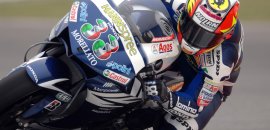Racing EncyclopediaFrom TrackpediaThe Racing Encyclopedia is mean to be a reference guide to all topics dealing with car setup and tuning. For example if you want to know the meaning of oversteer versus understeer you would check these pages to get that information. *APEX - the geometric middle point of the turn. *APEX CONE - marks the mid point of a turn. *BALANCE - maintaining the cars surefootedness or traction on the track by using steering, brake and throttle inputs. The cars balance may be one or a combination of these: YAW, PITCH and ROLL. *CONTINUIOUS RADIUS - a type of turn of which the radius remains constant throughout. *DECREASING RADIUS - a type of turn of which the radius shortens making the turn tighter at the exit. *DOUBLE APEX - some long turns have a "double apex"....ask your instructor.... *EARLY APEX - turning in to meet the apex a bit earlier than the geometric apex. *FALSE GRID - an area used to "grid" the next group of cars to use the track. *GRID - an area for the formation of cars in preparation to enter the track. *GRID TECH - at-track inspection of cars prior to starting event. *HEEL AND TOE - right foot fancy braking: brake pedal and accelerator depressed at the same time during downshifting / braking. *IF YOU SPIN BOTH FEET IN - if you start to spin, depress clutch and brake pedal all the way in, hard! Come to a complete stop. *INCREASING RADIUS - a type of turn of which the radius lengthens making the turn wider at the exit. *LATE APEX - turning in to meet the apex a bit later than the geometric apex. *LIFTING - letting up on the gas pedal. Don't do this abruptly in a turn. *OFF TRACK EXCURSION - you went off the track...try to do so in as straight a line as possible. Do not re-enter until told to do so by flaggers. *PADDOCK - area behind pits where drivers park their cars, park trailers, stow gear, change tires, etc. *PASSING SIGNALS - car being passed stays on line and indicates car behind can pass on right by putting left arm out window, elbow bent, finger pointing over the car; to indicate car behind can pass you on the left, extend left arm out window and point to the left. *PIT AREA - area next to track where cars come in from track and out go out onto track...usually in front of tower and start / finish. *PIT IN - place where cars enter pit area from track. *PIT IN SIGNAL - left arm out the window, bent at elbow, hand in a fist: indicates to other cars you are going into the pits. *PIT OUT - place where cars go out onto track. *PITCH - the motion of the car from front to rear or rear to front as in accellerating or braking. *ROLL - the motion of the vehicle from side to side or right to left/left to right. *RUN GROUP - group of drivers assigned to be on the track at the same time you are. Drivers are assigned according to number of track days and ability. There are generally 5 run groups: green (beginner), yellow, white, black and red (instructor). *STAGING - the 10 minutes prior to your run group being allowed on the track (thus the last 10 minutes of track time for the run group ahead of you) ...all cars in your run group assemble in the pit area...belt in, adjust mirrors, put on helmet, etc. *STRAIGHT - any stretch of track that one can get the car to wide open throttle between two turns. *THROTTLE MAINTANENCE - when traversing a long fast sweeping turn, it maybe necessary to lightly breath the throttle to maintain balance of the car. Avoid other cars, or to correct your line. *TRACK OUT POINT - marking / cone on track denoting where on track you should be ending your turn. *TURN IN CONE - cone at the beginning of the turn denoting where on the track you should commence the turn. *TWO SPIN RULE - in you have 2 spins, 2 off courses or a combination of these, you will not be allowed to enter the track again during this driver education event. *YAW - the vehicles orientation to its path of travel. i.e., the nose may be pointing into the line that is is traveling on. Like course and heading as in sailing.
Use of flagsIn open-wheel, stock-car and other types of circuit auto races, flags are displayed to indicate the general status of a race and to communicate instructions to competitors in a race. While the flags have changed from the first years (e.g. red used to start a race), these are generally accepted for today.
|
